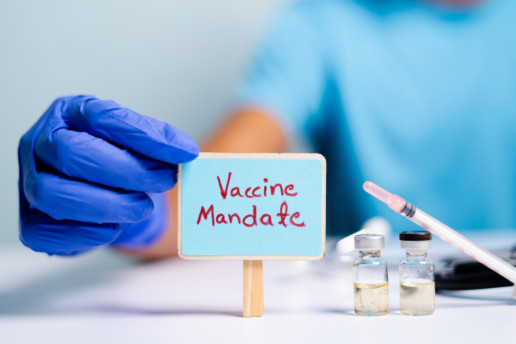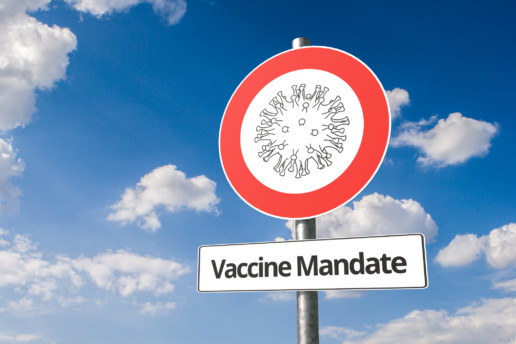SCOTUS BLOCKS FEDERAL VACCINE MANDATE
After a long road of legal challenges and in a much-anticipated ruling, moments ago, the United States Supreme Court blocked the COVID-19 Vaccine Mandate.
In the final blow to the sweeping requirements set to impact over 80 million workers across the nation and their employers, SCOTUS found that the Emergency Temporary Standard (ETS) issued by the Occupational Safety and Health Administration (OSHA) exceeded the power given to them by Congress. This means that the requirements for employers with 100+ employees to implement policies that required employees to receive the COVID vaccine or wear masks and test weekly is dead in the water.
"Although Congress has indisputably given OSHA the power to regulate occupational dangers, it has not given that agency the power to regulate public health more broadly," the court's majority said. "Requiring the vaccination of 84 million Americans, selected simply because they work for employers with more than 100 employees, certainly falls in the latter category."
Further, the court ruled that OSHA lacked the authority to impose such a mandate because the law that created OSHA "empowers the Secretary to set workplace safety standards, not broad public health measures."
"Although COVID-19 is a risk that occurs in many workplaces, it is not an occupational hazard in most," the Court ruled. "COVID–19 can and does spread at home, in schools, during sporting events, and everywhere else that people gather. That kind of universal risk is no different from the day-to-day dangers that all face from crime, air pollution, or any number of communicable diseases."
Alongside the ruling on the OSHA ETS case, the U.S. Supreme Court will allow a portion of the CMS mandate impacting an estimated 10 million health care workers to be enforced. The allowable portion of the CMS mandate requires vaccinations for health care workers who treat Medicare and Medicaid patients at facilities that receive federal funding.
In this ruling, the Court noted that "healthcare facilities that wish to participate in Medicare and Medicaid have always been obligated to satisfy a host of conditions that address the safe and effective provision of healthcare, not simply sound accounting."
Please check back with us as we work to source additional information and resources, particularly next steps for employers who may have already implemented requirements for their workforce, and taking the necessary steps to ensure you continue to meet your state requirements in your workplace.
SCOTUS Decision On Vaccine Mandate: How it Works
At 12 a.m. on January 13th, SCOTUS published a post that they would be live blogging as the court released opinions in one or more argued cases from the current term. Many experts quickly jumped to the conclusion that there was a high likelihood that the ruling on both the OSHA and CMS cases may be the highlight only to be very quickly disappointed. This early speculation led to a frustrating letdown today as SCOTUS did not release an opinion on the vaccine mandate.
If like many, you are watching the play-by-play in the news and just want a direct line to the ruling when it comes, here is some information, resources, and quick tips that may help you!
Decision Day
With SCOTUS decisions, it is not as simple as saying we will be able to tune in for X decision on X date. The U.S. Supreme Court does not set dates for releasing opinions but rather posts digitally to a public calendar when opinions will be released without noting what opinions will be included in that release. For example, SCOTUS updated its calendar yesterday for the remainder of January including the note that one new opinion would be released today. Of course, speculation began to fly as to whether the opinion released would be that on the OSHA/ETS cases.
SCOTUS Opinion Releases: How It Works
SCOTUS opinions are often accompanied by a public reading of at least part of the final decision read aloud by the Justice that authored the majority opinion. Opinions are often available for public consumption either via the live SCOTUS blog and/or a live stream (audio and/or video) on the SCOTUS website homepage. Opinion days are posted to the SCOTUS calendar and released at 10am EST on the posted calendar date. If you are watching the releases live there are a couple of good things to know:
- How do I know they have finished releasing opinions for a given day? Opinions are released with an associated number. These are the numbers that correspond to opinions in the left-most column on the court's opinion page. When the court releases multiple opinions on a single day, the R numbers don't appear until the court has released its final opinion of the day. So when an R number DOES appear (as it did for Babcock today), we can be sure the court is done for the day.
- Are there any exceptions? White flags of impatience were being raised across the SCOTUS blog this morning with many expecting and not getting the decision for the OSHA/CMS cases. Given that there are no additional opinion issuance dates on the SCOTUS calendar for the month of January, questions and frustrations began to fly. However, just because you don't see it on the calendar now, doesn't mean a decision is not imminent.
- Opinion issuance days tend to only be scheduled a few days out. And with the opinion announcements purely electronic, we could theoretically get them even when the justices are theoretically on their winter recess -- a change from non-pandemic times.
- Emergency applications are different: Rulings on the vaccine cases could technically come at any time (because they are on the emergency docket, so the court might not announce in advance when they are coming).
Resources to Stay Up-To-Date with SCOTUS
What Employers Should Do While Mandate Is In Limbo?
Make no mistake that both the OSHA ETS and the CMS Healthcare Mandate already have compliance obligations in effect, and you can’t wait until the Court decides in order to act.
While some employers are taking a more conservative approach opting to 'slow roll' plans, policies and issuance of guidance for employees, other employers are moving forward with full compliance anticipating the ETS surviving the Supreme Court. No matter which camp you are in, one of the most vital things needed is consistent and clear communications to your employees on what they can expect in the coming days and where the company stands in regard to implementation and requirements for Vax-or-Test policies.
Currently, OSHA is looking for good faith efforts that employers are beginning to take steps towards compliance with full implementation of the requirements beginning February 1, 2022. To better understand the implications of OSHA's timeline and the definition of 'good faith', please take a look at our more detailed post better outlining what employers need to know.
Vaccine Mandate Status: Mid-Week Update
Here we are mid-week, and employers across the nation impatiently await word from the U.S. Supreme Court as to whether they will allow the OSHA ETS requiring employers with 100 or more employees to implement vaccinate-or-test policies in the workplace.
Here's What We Know
The Supreme Court's decision is pending. Since hearing the oral arguments on Friday, January 7th, there has been plenty of speculation regarding where the ruling may land, or if the court will issue a brief administrative stay until a decision can be made. In the meantime, the first compliance deadline of the ETS is here, so what does that mean for employers awaiting this decision?
What Employers Need to Know
OSHA's initial deadline of January 10th is based upon good-faith efforts being made by employers. So, what is considered 'good-faith efforts'?
- Employers should show that they are beginning to make efforts to comply with the mandate.
- Company leadership should be communicating a clear approach to how they plan to comply with this new policy.
- OSHA-covered employers must begin moving forward with a Vax-or-Test policy by
- Determining the vaccination status of all its employees by obtaining acceptable proof of vaccination,
- Maintain a roster of employee vaccination status,
- Unvaccinated employees should be wearing face coverings,
- Instate a policy for paid time off for vaccination and vaccination side effects,
- Provide guidance on how employees should provide (prompt) notice of a positive COVID-19 test or diagnosis,
- Ensure you are in compliance with not only the OSHA ETS, but also any state laws or mandates regarding testing, masking, vaccination, and PTO.
U.S. Supreme Court Hears Oral Arguments on OSHA ETS
OSHA ETS: Where are we now and what do we know
The United States Supreme Court heard oral arguments today on the legality of the ETS issued by the Occupational and Safety Administration in early November. Since the ETS release, legal challenges have been making their way through the legal system taking employers nationwide on a bit of a see-saw ride on whether the ETS will or will not be instituted come Monday.
Previous to the oral arguments today, on December 17th, a three-judge panel from the 6th Circuit Court of the United States lifted the latest stay and revived the ETS with immediate effect. Within hours of the ruling, an appeal was filed to the US Supreme Court by its challengers and OSHA made announcements on a timeline for enforcement.
Latest ‘Need to Know’ for Employers
Pending any overarching changes that may come from a Supreme Court ruling after oral arguments today, the ETS will take immediate effect on Monday, January 10th. OSHA has announced that it will not issue citations for noncompliance with any requirements of the ETS before January 10th, nor will it issue citations for noncompliance with the standard’s testing requirements before February 9th so long as an employer is exercising reasonable good faith efforts to come into compliance with the standard. Given that these dates are basically upon us, what next steps should an employer be focused on now?
- Determine if you are indeed covered by the ETS. To do so you need to answer the following:
- Is your workplace normally covered by OSHA?
- Do you have more than 100 employees nationwide?
- Are you exempt because you are covered by another ETS or mandate (i.e. Healthcare COVID-19 ETS or Federal Contractor mandate)?
- Gather vaccine status on your workforce.
- Develop the required vaccination roster for employees. Note whether the employee is fully vaccinated (as defined by the ETS).
- Determine if you will mandate vaccines or conduct testing.
- .Develop your vaccine-or-test policy.
- Create the required mandatory vaccine and/or testing/masking policies required under the ETS.
- Be prepared to implement said policy should the OSHA ETS move forward to enforcement or if the Supreme Court ruling does not change the current ETS status.
- Conduct compliance training & educate the workforce.
- Ready communications to inform and educate your workforce about your new policies, including posting necessary notices.
- Offer training for your managers to aid them in proper communication and enforcement of the said policy.
- Prepare a process/procedure for unvaccinated employee testing.
- Keep a roster of unvaccinated employees, as well as documentation of weekly test and test result.
- Provide a clear policy/procedure for testing and submitting test results.
- Keep negative/positive test results documented per employee as employees testing positive within the immediately preceding 90 days do not have to comply with a testing requirement.
- Provide clear policies for employees (vaccinated or unvaccinated) who may test positive for COVID-19.
- Handling exemptions:
- Federal law requires that you still need to consider and possibly accommodate valid medical and religious accommodation requests to a vaccination requirement.
- Ensure your policies provide provisions explaining how employees can request exemptions, including providing access to necessary paperwork, timelines for submission, and any additional policies or procedures that may impact exempt employees (such as remote work requirements, etc).
What’s Next?
Again, we wait to see what the justice system concludes. While many assumptions and predictions are being made, we simply don’t know what we don’t know. The only facts currently are, as of today (January 7, 2022):
- The OSHA ETS is due to take effect on Monday, January 10, 2022
- The oral arguments to both the employer mandate and the CMS rule have concluded. The US Supreme Court is expected to either institute a stay to allow additional time to review the arguments and make a ruling or, and less likely, issue an immediate ruling on the legality of the OSHA ETS and its implementation. Should a stay be issued by the high court, it is widely expected to be announced sometime over the weekend before the ETS can take effect on Monday.
Stay Tuned next week for more details as we monitor this developing situation.
Senate Passes Bill to Overturn Biden Vaccine Mandate
Yesterday, in the latest blow to Biden's vaccine mandate for businesses, the United States Senate passed a bill that would overturn President Joe Biden's COVID-19 vaccine mandate for private businesses. The legislation will now go to the House of Representatives, where it potentially faces strong opposition. If it passes in the House, Biden has threatened to veto it. While this is significant in terms of the ongoing battle to prove the legality of the mandate itself, it doesn't change much for employers. So what does it all mean and what happens next?
Quick Catch Up:
-
All three orders of the vaccine mandate, (employers with over 100 employees, federal contractors and subcontractors, and health care workers), have been temporarily blocked from being enforced via separate court rulings. These rulings have effectively barred any implementation nationwide.
-
For now, there are no deadlines related to the original ETS or Executive Orders that employers are required to meet regarding COVID-19 vaccination policies or enforcement of vaccination or testing amongst employees.
The Vaccine Mandate Timeline:
- 9/9/21: Biden Administration announces new COVID-19 Action plan, the first portion of which involved:
- The signing of two new Executive Orders that would require vaccinations for all federal workers and contractors.
- Instructed the Department of Labor's (DOL) Occupational Safety and Health Administration (OSHA) to develop a rule requiring employers with 100 or more employees to ensure their workforce is fully vaccinated to require unvaccinated workers to produce weekly negative test results leveraging the use of an emergency temporary standard (ETS).
- Instructed the Centers for Medicare and Medicaid Services (CMS) to develop a rule requiring workers in health care settings that receive Medicare and Medicaid reimbursements to implement vaccination and testing protocols.
- 11/4/21: The U.S. Department of Labor's Occupational Safety and Health Administration (OSHA) issued an emergency temporary standard (ETS) requiring large employers (100+ employees) to develop, implement and enforce a COVID-19 vaccination policy or institute a policy to allow employees to choose between vaccination and weekly testing.
- 11/5/21: ETS took effect on 11/5/21.
- 12/5/21: Employers were to have vaccination policies in place.
- 1/4/22: Deadline for employers to be in compliance; employees to be fully vaccinated or begin regular testing.
- 11/5/21: The 5th U.S. Circuit Court of Appeals issued a stay on the ETS, citing challenges the plaintiffs brought against the ETS "show a great likelihood of success on the merits."
- 11/12/21: The 5th Circuit Court of Appeals extended the original order made on 11/5/21.
- 11/16/21: The 6th U.S. Circuit Court of Appeals was selected in a lottery held by the Judicial Panel on Multidistrict Litigation to hear 34 consolidated challenges to the ETS.
- The date for this hearing has not yet been scheduled. It has been noted that the court is not expected to rule on the stay until December 10th at the earliest.
- 11/30/21: U.S. District Court issued a nationwide preliminary injunction to halt the start of President Biden's national vaccine mandate for health care workers.
- 12/2/21: Centers for Medicare and Medicaid Services (CMS) issued a memo announcing it was suspending enforcement of the mandate due to U.S. District Court ruling while it appeals the court decisions.
- 12/7/21: U.S. District Court issued a nationwide stay barring the enforcement of Executive Order 14042 for federal government contractors and subcontractors until further notice.
What's Next?
Keep an eye out for updates, particularly from the 6th Circuit Court of Appeals which is the next decision expected before we wrap 2021. However, no matter the outcome at the 6th Circuit Court, this is very likely to eventually make its way to the Supreme Court. Stay tuned and stay well!
OSHA Suspends Implementation and Enforcement of ETS
On November 16, 2021, OSHA (Occupational Safety and Health Administration) published that the COVID-19 vaccination and testing ETS (Emergency Temporary Standard) is being put on hold due to pending litigation.
What We Know
- The OSHA ETS went into effect on November 5th, 2021.
- The ETS has two compliance dates important to employers with 100 or more employees.
- December 5th: Employers were to finalize their policies on vaccine mandates and weekly testing requirements
- January 4th: Employers were to be in compliance with weekly testing by this date.
- The vaccine mandate has met legal challenges wherein on November 12, 2021, the 5th Circuit Court of Appeals upheld a stay. The stay order issued by the three-judge panel directs OSHA to “take no steps to implement or enforce” the ETS.
- Until the stay is lifted or a ruling is reached, the ETS is not in effect and employers do not need to comply with the January 4, 2022 deadline.
- On November 16th, a federal appeals court in Cincinnati (the 6th Circuit Court of Appeals) has won the lottery to handle the consolidated case challenging the ETS. No date has been set on when this court will make a ruling.
The 5th Circuit Court of Appeals Ruling
On Nov. 12, 2021, the 5th Circuit Court of Appeals ruled to extend the stay of the OSHA ETS, stating the ETS imposes financial burdens on private employers. The court also claimed that the ETS fails to account for the different elements present between workplaces. Overall, the court raised substantial questions on whether OSHA has proven that COVID-19 presents a “grave danger” to workers and if the ETS is “necessary.”
Circuit Court Lottery
Attorneys general, employers, unions, and other organizations filed 34 petitions seeking review of the OSHA rule in 12 different circuit courts, according to the U.S. Judicial Panel on Multidistrict Litigation. All of the lawsuits concerning the ETS for all Circuit court districts were then consolidated and, through a "lottery drawing" the Judicial Panel on Multidistrict Litigation randomly determined which Circuit court would review the arguments.
On November 16th, a federal appeals court in Cincinnati (the 6th Circuit Court of Appeals) has won the lottery to handle the consolidated case challenging the ETS. No date has been set on when this court will make a ruling.
While the Sixth Circuit won the random draw, the lottery doesn’t necessarily end the jockeying over which court will ultimately hear the case. Parties can petition circuit courts to transfer the case elsewhere.
And no matter what happens at the circuit court level, the U.S. Supreme Court is likely to have the final say on the vaccinate-or-test emergency temporary standard. Yet the appeals court’s decision could set the table for the justices by framing the debate and raising which legal questions will determine the rule’s fate.
Next Steps for Employers
- Continue to monitor updates for changes in status to OSHA's ETS
- Be prepared in the event the ETS survives the upcoming litigation
- Remember employers still have a continued duty to make their workplaces safe for employees.
Statement from OSHA
OSHA released a statement on its website. The statement reads:
“On Nov. 12, 2021, the U.S. Court of Appeals for the 5th Circuit granted a motion to stay OSHA’s ETS, published on Nov. 5, 2021 (86 Fed. Reg. 61402). The court ordered that OSHA ‘take no steps to implement or enforce’ the ETS ‘until further court order.’ While OSHA remains confident in its authority to protect workers in emergencies, OSHA has suspended activities related to the implementation and enforcement of the ETS, pending future developments in the litigation.”
OSHA ETS: Vaccination & Testing Requirements Published
UPDATE 11/5: OSHA has issued an extensive FAQ (https://www.osha.gov/coronavirus/ets2/faqs) to help employers navigate the newly published ETS. Employers are expected to comply with most provisions regarding the vaccination and testing of employees by December 5th.
ETS for COVID-19 Vaccination and Testing Released
Over the last several weeks, employers have been waiting for the official ETS to be released to provide clarity on the timeline for implementation, associated fines for non-compliance, as well as documentation and reporting requirements.
Today, November 4, 2021, OSHA (Occupational Safety and Health Administration) announced a federal emergency temporary standard (ETS) to address the health and safety risks associated with COVID-19 in the workplace. Currently, the document is unpublished and is offered for public review. The ETS is scheduled to be published on November 5, 2021.
With the official release of the unpublished ETS, requirements are now made clear. We would expect additional guidance and FAQs to be released in the coming days to provide crucial insight for employers navigating the new requirements.
Who does the ETS impact?
- Private employers with 100 or more employees
- This is a company-wide employee count and not a per location count.
Timeline for employers to comply with the ETS
- Most provisions will require compliance by December 5, 2021
- Testing requirements must be met by January 4, 2021
- State plans will have 30 days to adopt the federal ETS or implement their own standard. Those states are:
- Alaska | Arizona | California | Hawaii | Indiana | Iowa | Kentucky | Maryland | Michigan | Minnesota | New Mexico | Nevada | North Carolina | Oregon | Puerto Rico | South Carolina | Tennessee | Utah | Vermont | Virginia | Washington | Wyoming
What are the ETS Requirements?
- Develop, implement and enforce a mandatory COVID-19 vaccination policy; OR
- Develop, implement and enforce a policy allowing employees to choose to either
- get a vaccination or
- wear a face-covering in the workplace and have weekly COVID-19 testing done.
Employer Responsibility Under the ETS
- Determine the vaccination status of each employee
- Obtain acceptable proof of vaccination
- The record of immunization from a health care provider or pharmacy
- A copy of the COVID-19 Vaccination Record Card
- A copy of medical records documenting the vaccination
- A copy of immunization records from a public health, state or tribal immunization information system
- A copy of any other official documentation that contains the type of vaccine administered, date administered and name of the health care professional or clinic
- Retain a roster of each employee’s vaccination status. These documents are considered to be employee medical records and must be maintained in accordance with 29 CFR 1910.1020. These records are not subject to regular retention requirements but must be retained while the ETS is in effect.
- Any employee not able to provide one of the acceptable forms of proof of vaccination must be treated as not fully vaccinated for the purpose of the ETS. In instances where the employee is unable to produce acceptable proof of vaccination, per above a signed and dated statement by the employee, subject to criminal penalties for knowingly providing false information, including:
- Attesting to their vaccination status (full or partial vaccination)
- Attesting that they have lost or are otherwise unable to produce proof required by the ETS
- The employer must report to OSHA:
- Each work-related COVID-19 fatality within 8 hours of employer learning of the fatality
- Each work-related COVID-19 in-patient hospitalization within 24 hours of the employer learning about the in-patient hospitalization.
ETS Weekly Testing Requirements
A COVID-19 test means a test for SARS-CoV-2 that is:
- cleared, approved or authorized by the FDA
- administered in accordance with authorized instructions
- not self administer and self-read unless observed by the employer or an authorized telehealth proctor.
Testing Timeline and Who Must Test
- An employee who reports at least once every 7 days to a workplace where others are present
- Must be tested once every 7 days
- Must provide documentation of the most recent COVID-19 test result to the employer no later than the 7th day following the date on which the employee last provided test results
- Employees who do not report during a period of 7 or more days to a workplace where other individuals are present
- Must be tested within seven days prior to returning to the workplace
- Must provide documentation of that test result to the employer upon return to the workplace
- Employers are not required to cover the cost of the testing*
- *Note: Employer payment for testing may be required by other laws, regulations, collective bargaining agreements or other collectively negotiated agreements.
Who is Exempt from the ETS?
- Employees who do not work with others present
- Employees working from home
- Employees who work exclusively outdoors
- Employees covered under the Safer Federal Workforce Task Force
- Employees under the Health Care ETS
- Employers with fewer than 100 employees
- Public employers in states without state plans
- Employees holding a sincerely held religious belief must be allowed reasonable accommodation under the Equal Employment Opportunity Commission’s guidelines (https://www.eeoc.gov/wysk/what-you-should-know-about-covid-19-and-ada-rehabilitation-act-and-other-eeco-laws).
- Employees for whom a vaccine is medically contraindicated
- Employees for whom medical necessity requires a delay in vaccination
What Paid Leave Provisions are in the ETS?
- Employers are required to provide reasonable time for each employee to obtain each of their primary vaccination series and allow up to four hours of paid time at the employee’s regular rate of pay for this purpose
- Reasonable time and paid sick leave are required for recovery from side effects of the vaccination
- Employees must provide immediate notice of a positive COVID-19 test/diagnosis and must meet criteria before being allowed to return to work
- No weekly testing will be required for 90 days following the date of their positive COVID-19 test or diagnosis
- The employer must maintain a record of each test result provided by each employee
- The employer must keep the employee removed from the workplace until the employee:
- receives a negative result on a COVID-19 nucleic acid amplification test (NAAT) following a positive result on a COVID-19 antigen test if the employee chooses to seek a NAAT test for confirmatory testing;
- meets the return to work criteria in CDC’s “Isolation Guidance”; or
- receives a recommendation to return to work from licensed healthcare provider
- The ETS does not require employers to provide paid time off to any employee for removal from the workplace due to a positive COVID-19 test or diagnosis
What Other Clarifications are in the ETS?
- Prior COVID-19 Infection:
- OSHA determined workers who have been previously infected with COVID-19 still face grave danger from workplace exposure and without additional supporting scientific evidence of immunity will still be required to comply with the standards set forth.
- The basis for OSHA’s ‘grave danger’ finding is that employees can be exposed to the virus in almost any work setting; that exposure can lead to infection and that infection can cause death or serious impairment of health, particularly in the unvaccinated.
- Although this ETS does not impose a strict vaccination mandate, OSHA has determined that, to adequately address the grave danger that COVID-19 poses to unvaccinated workers, a more proactive approach is necessary than simply requiring employers to make vaccination available to employees.
- Although the ETS does not require all covered employers to implement a mandatory vaccination policy, OSHA expects that employers that choose that compliance option will enjoy advantages that employers that opt-out of the vaccination mandate option will not.
- Under the ETS, fully vaccinated means a person’s status 2 weeks after completing primary vaccination or the second dose of a two-dose series with a COVID-19 vaccine
- Clarification on what employers are impacted by the ETS were provided by OSHA through a series of examples:
- If an employer has 75 part-time employees and 25 full-time employees, the employer would be within the scope of this ETS because it has 100 employees.
- If an employer has 150 employees, 100 of whom work from their homes full-time and 50 of whom work in the office at least part of the time, the employer would be within the scope of this ETS because it has more than 100 employees.
- If an employer has 102 employees and only 3 ever report to an office location, that employer would be covered.
- If an employer has 150 employees, and 100 of them perform maintenance work in customers’ homes, primarily working from their company vehicles (i.e., mobile workplaces), and rarely or never report to the main office, that employer would also fall within the scope.
- If an employer has 200 employees, all of whom are vaccinated, that employer would be covered.
- If an employer has 125 employees, and 115 of them work exclusively outdoors, that employer would be covered.
- If a single corporation has 50 small locations (e.g., kiosks, concession stands) with at least 100 total employees in its combined locations, that employer would be covered even if some of the locations have no more than one or two employees assigned to work there.
- If a host employer has 80 permanent employees and 30 temporary employees supplied by a staffing agency, the host employer would not count the staffing agency employees for coverage purposes and therefore would not be covered. (So long as the staffing agency has at least 100 employees, however, the staffing agency would be responsible for ensuring compliance with the ETS for the jointly employed workers.)
- If a host employer has 110 permanent employees and 10 temporary employees from a small staffing agency (with fewer than 100 employees of its own), the host employer is covered under this ETS and the staffing agency is not.
- If a host employer has 110 permanent employees and 10 employees from a large staffing agency (with more than 100 employees of its own), both the host employer and the staffing agency are covered under this standard, and traditional joint employer principles apply.
- Generally, in a traditional franchisor-franchisee relationship, if the franchisor has more than 100 employees but each individual franchisee has fewer than 100 employees, the franchisor would be covered by this ETS but the individual franchises would not be covered.
ETS from OSHA on Vaccination and Testing Released
UPDATE 11/5:
OSHA has issued an extensive FAQ (https://www.osha.gov/coronavirus/ets2/faqs) to help employers navigate the newly published ETS. Employers are expected to comply with most provisions regarding the vaccination and testing of employees by December 5th.
ETS for COVID-19 Vaccination and Testing Released
Over the last several weeks, employers have been waiting for the official ETS to be released to provide clarity on the timeline for implementation, associated fines for non-compliance, as well as documentation and reporting requirements.
Today, November 4, 2021, OSHA (Occupational Safety and Health Administration) announced a federal emergency temporary standard (ETS) to address the health and safety risks associated with COVID-19 in the workplace. Currently, the document is unpublished and is offered for public review. The ETS is scheduled to be published on November 5, 2021.
With the official release of the unpublished ETS, requirements are now made clear. We would expect additional guidance and FAQs to be released in the coming days to provide crucial insight for employers navigating the new requirements.
Who does the ETS impact?
- Private employers with 100 or more employees
- This is a company-wide employee count and not a per location count.
Timeline for employers to comply with the ETS
- Most provisions will require compliance by December 5, 2021
- Testing requirements must be met by January 4, 2021
- State plans will have 30 days to adopt the federal ETS or implement their own standard. Those states are:
- Alaska | Arizona | California | Hawaii | Indiana | Iowa | Kentucky | Maryland | Michigan | Minnesota | New Mexico | Nevada | North Carolina | Oregon | Puerto Rico | South Carolina | Tennessee | Utah | Vermont | Virginia | Washington | Wyoming
What are the ETS Requirements?
- Develop, implement and enforce a mandatory COVID-19 vaccination policy; OR
- Develop, implement and enforce a policy allowing employees to choose to either
- get a vaccination or
- wear a face-covering in the workplace and have weekly COVID-19 testing done.
Employer Responsibility Under the ETS
- Determine the vaccination status of each employee
- Obtain acceptable proof of vaccination
- The record of immunization from a health care provider or pharmacy
- A copy of the COVID-19 Vaccination Record Card
- A copy of medical records documenting the vaccination
- A copy of immunization records from a public health, state or tribal immunization information system
- A copy of any other official documentation that contains the type of vaccine administered, date administered and name of the health care professional or clinic
- Retain a roster of each employee's vaccination status. These documents are considered to be employee medical records and must be maintained in accordance with 29 CFR 1910.1020. These records are not subject to regular retention requirements but must be retained while the ETS is in effect.
- Any employee not able to provide one of the acceptable forms of proof of vaccination must be treated as not fully vaccinated for the purpose of the ETS. In instances where the employee is unable to produce acceptable proof of vaccination, per above a signed and dated statement by the employee, subject to criminal penalties for knowingly providing false information, including:
- Attesting to their vaccination status (full or partial vaccination)
- Attesting that they have lost or are otherwise unable to produce proof required by the ETS
- The employer must report to OSHA:
- Each work-related COVID-19 fatality within 8 hours of employer learning of the fatality
- Each work-related COVID-19 in-patient hospitalization within 24 hours of the employer learning about the in-patient hospitalization.
ETS Weekly Testing Requirements
A COVID-19 test means a test for SARS-CoV-2 that is:
- cleared, approved or authorized by the FDA
- administered in accordance with authorized instructions
- not self administer and self-read unless observed by the employer or an authorized telehealth proctor.
Testing Timeline and Who Must Test
- An employee who reports at least once every 7 days to a workplace where others are present
- Must be tested once every 7 days
- Must provide documentation of the most recent COVID-19 test result to the employer no later than the 7th day following the date on which the employee last provided test results
- Employees who do not report during a period of 7 or more days to a workplace where other individuals are present
- Must be tested within seven days prior to returning to the workplace
- Must provide documentation of that test result to the employer upon return to the workplace
- Employers are not required to cover the cost of the testing*
- *Note: Employer payment for testing may be required by other laws, regulations, collective bargaining agreements or other collectively negotiated agreements.
Who is Exempt from the ETS?
- Employees who do not work with others present
- Employees working from home
- Employees who work exclusively outdoors
- Employees covered under the Safer Federal Workforce Task Force
- Employees under the Health Care ETS
- Employers with fewer than 100 employees
- Public employers in states without state plans
- Employees holding a sincerely held religious belief must be allowed reasonable accommodation under the Equal Employment Opportunity Commission's guidelines (https://www.eeoc.gov/wysk/what-you-should-know-about-covid-19-and-ada-rehabilitation-act-and-other-eeco-laws).
- Employees for whom a vaccine is medically contraindicated
- Employees for whom medical necessity requires a delay in vaccination
What Paid Leave Provisions are in the ETS?
- Employers are required to provide reasonable time for each employee to obtain each of their primary vaccination series and allow up to four hours of paid time at the employee's regular rate of pay for this purpose
- Reasonable time and paid sick leave are required for recovery from side effects of the vaccination
- Employees must provide immediate notice of a positive COVID-19 test/diagnosis and must meet criteria before being allowed to return to work
- No weekly testing will be required for 90 days following the date of their positive COVID-19 test or diagnosis
- The employer must maintain a record of each test result provided by each employee
- The employer must keep the employee removed from the workplace until the employee:
- receives a negative result on a COVID-19 nucleic acid amplification test (NAAT) following a positive result on a COVID-19 antigen test if the employee chooses to seek a NAAT test for confirmatory testing;
- meets the return to work criteria in CDC’s “Isolation Guidance”; or
- receives a recommendation to return to work from licensed healthcare provider
- The ETS does not require employers to provide paid time off to any employee for removal from the workplace due to a positive COVID-19 test or diagnosis
What Other Clarifications are in the ETS?
- Prior COVID-19 Infection:
- OSHA determined workers who have been previously infected with COVID-19 still face grave danger from workplace exposure and without additional supporting scientific evidence of immunity will still be required to comply with the standards set forth.
- The basis for OSHA's 'grave danger' finding is that employees can be exposed to the virus in almost any work setting; that exposure can lead to infection and that infection can cause death or serious impairment of health, particularly in the unvaccinated.
- Although this ETS does not impose a strict vaccination mandate, OSHA has determined that, to adequately address the grave danger that COVID-19 poses to unvaccinated workers, a more proactive approach is necessary than simply requiring employers to make vaccination available to employees.
- Although the ETS does not require all covered employers to implement a mandatory vaccination policy, OSHA expects that employers that choose that compliance option will enjoy advantages that employers that opt-out of the vaccination mandate option will not.
- Under the ETS, fully vaccinated means a person's status 2 weeks after completing primary vaccination or the second dose of a two-dose series with a COVID-19 vaccine
- Clarification on what employers are impacted by the ETS were provided by OSHA through a series of examples:
- If an employer has 75 part-time employees and 25 full-time employees, the employer would be within the scope of this ETS because it has 100 employees.
- If an employer has 150 employees, 100 of whom work from their homes full-time and 50 of whom work in the office at least part of the time, the employer would be within the scope of this ETS because it has more than 100 employees.
- If an employer has 102 employees and only 3 ever report to an office location, that employer would be covered.
- If an employer has 150 employees, and 100 of them perform maintenance work in customers’ homes, primarily working from their company vehicles (i.e., mobile workplaces), and rarely or never report to the main office, that employer would also fall within the scope.
- If an employer has 200 employees, all of whom are vaccinated, that employer would be covered.
- If an employer has 125 employees, and 115 of them work exclusively outdoors, that employer would be covered.
- If a single corporation has 50 small locations (e.g., kiosks, concession stands) with at least 100 total employees in its combined locations, that employer would be covered even if some of the locations have no more than one or two employees assigned to work there.
- If a host employer has 80 permanent employees and 30 temporary employees supplied by a staffing agency, the host employer would not count the staffing agency employees for coverage purposes and therefore would not be covered. (So long as the staffing agency has at least 100 employees, however, the staffing agency would be responsible for ensuring compliance with the ETS for the jointly employed workers.)
- If a host employer has 110 permanent employees and 10 temporary employees from a small staffing agency (with fewer than 100 employees of its own), the host employer is covered under this ETS and the staffing agency is not.
- If a host employer has 110 permanent employees and 10 employees from a large staffing agency (with more than 100 employees of its own), both the host employer and the staffing agency are covered under this standard, and traditional joint employer principles apply.
- Generally, in a traditional franchisor-franchisee relationship, if the franchisor has more than 100 employees but each individual franchisee has fewer than 100 employees, the franchisor would be covered by this ETS but the individual franchises would not be covered.
ARPA: What Employers Need to Know
On March 10, 2021 Congress passed the American Rescue Plan Act (ARPA) of 2021, which was signed into law on March 11th. The ARPA attempts to address and help mitigate some of the far-reaching financial impacts of the COVID-19 pandemic. In addition to those provisions, the ARPA contains provisions that are of special interest to employers and employees.
into law on March 11th. The ARPA attempts to address and help mitigate some of the far-reaching financial impacts of the COVID-19 pandemic. In addition to those provisions, the ARPA contains provisions that are of special interest to employers and employees.
The ARPA Nitty Gritty
- COBRA Subsidy - A 100% premium subsidy is provided, funded through employer tax credits.
- FFCRA Leave - Employer tax credits have been extended through September 30, 2021.
- FFCRA Leave - Inclusion of testing and immunization as qualifying reasons for FFCRA leave.
- FFCRA Tax Credits - Definition of employee earnings eligible have been expanded.
- Unemployment - The $300 weekly increase has been extended and expanded.
- ACA - Exchange insurance subsidies are increased.
- DCAP - Contribution limits have been increased.
- Employee Retention Tax Credit - Extended and expanded eligibility for some businesses.
Let's Break It Down
COBRA Subsidy
What is it?
COBRA (Consolidated Omnibus Budget Reconciliation Act of 1986) allows employees who would lose employer-sponsored health insurance because of job loss (or reduction in working hours) to continue that insurance for 18 months. However, the employer can require the employee that elects COBRA coverage to pay the entire cost of the premium oftentimes creating a necessary, but an unexpected financial burden for the employee.
ARPA Provisions
- 100% subsidy of COBRA premiums from April 1, 2021, through September 30, 2021, for employees and their family members who lost health insurance due to involuntary termination or reduction in hours of their employment
- Allows employees who declined COBRA coverage, or elected it and dropped it, to elect subsidized COBRA
- Does not apply to employees who voluntarily terminated their employment or who qualify for another group health plan
Who Pays For It?
The subsidy is funded through the federal government through a refundable payroll tax credit.
Action Steps
- New employee notice requirements for plan administrators will be issued by the US Department of Labor
- Employees may elect subsidized COBRA starting April 1, 2021, through 60 days after receiving notice of the benefit
FFCRA Leave
What is it?
FFCRA (Families First Coronavirus Response Act) was passed in March 2020 and provided a tax credit for employers to fund two types of paid employee leave required by the law. These leave requirements expired in December 2020, but for employers that chose to continue providing FFCRA leave voluntarily, the tax credit was extended through March 2021.
ARPA Provisions
- Extends tax credit through September 30, 2021
- Adds a provision to include employee time off related to COVID-19 testing and immunization
- Increases the amount of wages eligible for the family leave credit from $10,000 to $12,000 per employee
- Provides an additional 10 days of voluntary emergency paid sick leave for employees beginning April 1, 2021
Unemployment
What is it?
Due to the COVID-19 pandemic, unemployment provisions were expanded under the previous administration to include three new federal unemployment programs. These programs were scheduled to end no later than April 2021.
- Pandemic Unemployment Assistance (PUA): Provided weekly benefits to independent contractors, self-employed individuals, and other workers that typically would not be eligible for unemployment benefits
- Pandemic Emergency Unemployment Compensation (PEUC): Provides weekly benefits to individuals who have exhausted their eligibility for all other unemployment benefits
- Federal Pandemic Unemployment Compensation: Provides an additional $300 weekly payment to individuals already receiving PUA, PEUC, or regular unemployment benefits
ARPA Provisions
- Previously established provisions that were set to expire have been extended through September 6, 2021
- Changes how unemployment benefits are taxed, exempting the first $10,200 from federal income tax for each spouse in households with under $150,000 in adjusted gross income.
ACA
What is it?
The ACA (Affordable Care Act) established health insurance exchanges for the purchase of individual health insurance coverage, as well as premium tax credits. These tax credits are not available to individuals with income at or above 400% of the federal poverty level.
ARPA Provisions
- Temporarily eliminates the income cap on subsidies for a period of two years
- Limits the total amount a household is required to pay for health coverage through the Exchanges to 8.5% of household income
- Increases federal subsidy amounts available for lower-income individuals, in some cases eliminating premium costs entirely
- Increases federal funding intended to encourage states to expand Medicaid programs (if they previously had not done so)
- All provisions are temporary and will expire in two years
DCAP
What is it?
A DCAP (Dependent Care Assistance Plan), also sometimes referred to as a dependent care flexible spending account (FSA), is an employee benefit plan that helps employees pay for the care of a qualifying dependent, such as a child or elder, as defined by Internal Revenue Service (IRS) regulations.
ARPA Provisions
- Increases annual contribution limit from $5,000 to $10,500 ($2,500 to $5,250 for married filing separately) for tax years beginning after December 31, 2020 and before January 1, 2022
- Employers meeting requirements can retroactively amend plans to incorporate the increase
Action Steps
- Employers with DCAPs can retroactively amend plans, if
- The amendment is adopted by the last day of the plan year in which it is effective; and
- The plan operates consistently with the terms of the amendment until it is adopted.
- It is recommended that you speak with your benefits advisor to ensure plans meet the requirements and stay in compliance
Employee Retention Tax Credit
What is it?
The Employee Retention Tax Credit was originally enacted with the CARES (Coronavirus Aid, Relief and Economic Security) Act. The credit was tended to encourage employers to retain employees on their payroll who were unable to work due to COVID-19 related reasons. This credit was set to expire in June of 2021.
ARPA Provisions
- Extends the credit through the end of 2021
- Expands eligibility to some small startups that began operating after February 15, 2020. Qualifying businesses will be eligible for a maximum credit of up to $50,000 per quarter even if they do not experience an eligible decline in gross receipts or a full or partial suspension
- Creates a new provision for 'severely financially distressed' employers which beginning in the third quarter of 2021 allows employers of any size to count all wages toward the $10,000 cap.
Pandemic drives business support for paid leave, study finds
A new study has found strong support from U.S businesses for a national paid leave policy after months of navigating the coronavirus pandemic and the ensuing recession.
Researchers found that 75% of U.S. companies and U.K.-based companies with U.S. operations said they support a government leave plan to help cope with future public health and economic crises. So far during the COVID-19 outbreak, 1 in 5 U.S. workers have taken a leave of some kind.
More than 40 companies of various sizes were surveyed in the study conducted by the nonprofit groups Promundo and Paid Leave for the U.S., which promote gender equity and paid leave policies, respectively.
The U.S. is alone among 41 industrialized countries in not guaranteeing paid sick or parental leave, according to the Organization for Economic Cooperation and Development. President Joe Biden has introduced a $1.9 trillion stimulus bill featuring temporary paid leave amid signs that support is on the rise on Capitol Hill and in corporate America for paid leave legislation.
“We’re beginning to see is a real demand for a permanent public policy solution,” said Annie Sartor, senior director of business partnerships at Paid Leave for the U.S.
The Families First Coronavirus Response Act passed at the onset of the pandemic included two weeks of paid sick leave and as much as 10 weeks of paid family or medical leave for employers with fewer than 500 employees. It expired in December.
Biden’s current proposal includes provisions for as much as 14 weeks of paid sick, family and medical leave and a significant expansion of eligibility. The plan could reach as many as 106 million more Americans than the last emergency bill, expanding coverage to workers at companies with fewer than 50 employees.
Biden’s rescue plan is “a first step” toward permanent legislation, said Michelle McGrain, director of congressional relations at the National Partnership for Women & Families.
“The lack of paid leave in this country was a huge crisis,” she said. “That crisis has continued throughout the pandemic and will continue to exist if big, structural changes are not engaged.”
Almost 45% of companies said more than half of the employees who took leave were women, who often bear the brunt of household and care-giving responsibilities.
Gary Barker, chief executive officer and founder of Promundo, said companies with leave programs cut their job losses, especially for women. In December, women accounted for all of the net jobs lost in the U.S., with 156,000, while men gained 16,000 jobs, according to the U.S. Bureau of Labor Statistics.
“It points to the importance of making leave normal for women and men, and for us to achieve the equality in salaries that women deserve,” Barker said.
Barker said companies in nations with mandatory leave have built a workplace culture that doesn’t penalize taking time-off.
“Workers worry about taking it,” particularly in the U.S., Barker said. “European countries, because they’ve been doing this for a very long time, you’re not considered a slacker because you take leave.”
SOURCE: Gardner, A. (26 January 2021) "Pandemic drives business support for paid leave, study finds" (Web Blog Post). Retrieved from https://www.benefitnews.com/articles/pandemic-drives-business-support-for-paid-leave-study-finds









